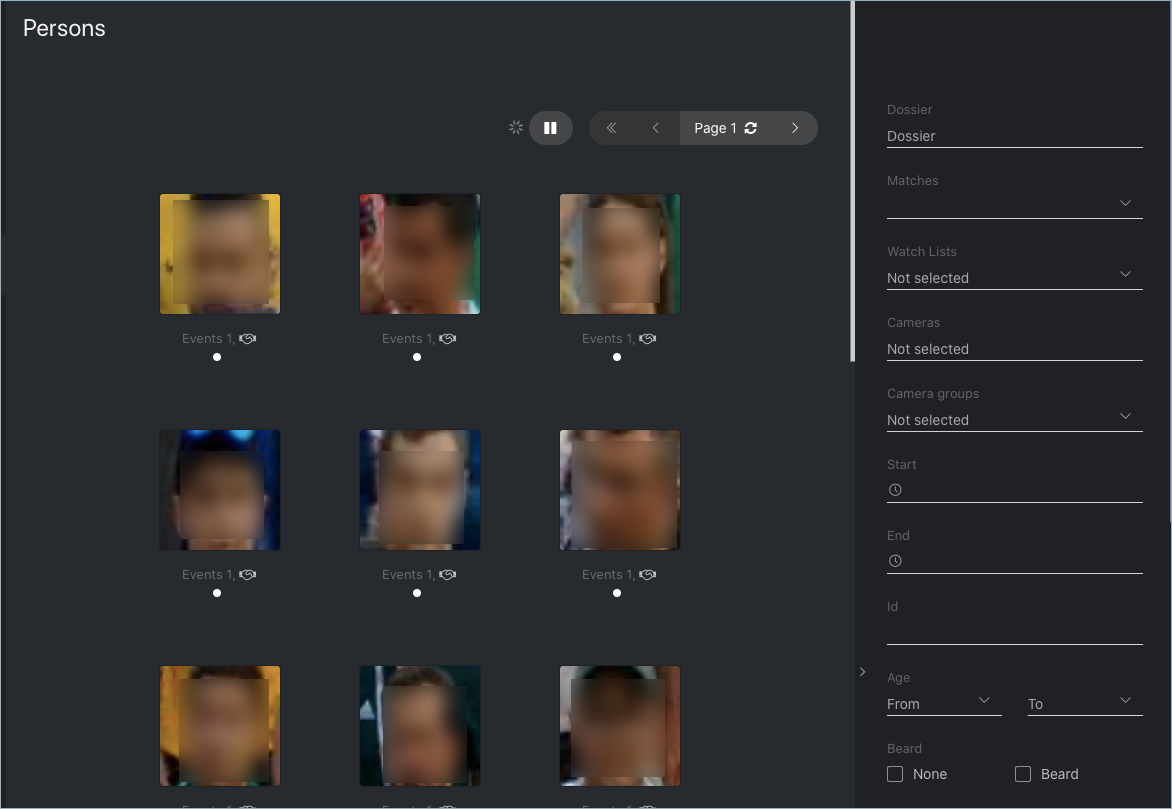Person Recognition
FindFace Multi allows for automatic person recognition. The system on the fly recognizes faces belonging to the same person and clusters them, creating a person gallery. You can work with the person gallery on the Persons tab.
Important
By default, the person clusterization is disabled. Enable and configure it via the /etc/findface-security/config.py configuration file.
In this section:
Clusterization Methods
FindFace Multi uses the following methods to cluster faces belonging to the same person:
Dynamic clusterization. The clusterization takes place on the fly after an episode is closed. The result of dynamic clusterization is shown in real-time on the Persons tab.
Note
The technical details are as follows. Not every episode is qualified: the number of events in it must be equal or greater than
PERSON_EVENT_MIN_EPISODE_EVENTS(set up via the/etc/findface-security/config.pyconfiguration file). If an episode meets this requirement, the system selects the best quality event and performs the following operations:Creates a new entity
person eventin the main system database PostgreSQL. The entity contains the event metadata, a link to the parent episode, face feature vector, and thumbnail.Searches for a similar face centroid in the
person_eventsgallery of the Tarantool feature vector database. A face centroid is a virtual feature vector averaged across all person’s faces that have been detected so far. If a similar centroid is found, the system updates it using the new event. Otherwise, it creates a new centroid.
Scheduled clusterization. We recommend scheduling it on late night hours as it takes up a lot of CPU resources and time.
Note
The schedule is defined in the RRULE format as
PERSONS_CLUSTERIZATION_SCHEDULEin the/etc/findface-security/config.pyconfiguration file. The rest of the technical implementation resembles the dynamic method. However, the face centroid quality is better in the scheduled method as centroids are averaged across a larger array of accumulated feature vectors.Important
The scheduled clusterization completely overwrites the person gallery, including ids, unless the
PIN_MATCHED_PERSONSparameter is enabled (see description below).
Enable and Configure Person Clusterization
By default, the person clusterization is disabled. To enable and configure it, do the following:
Open the
/etc/findface-security/config.pyconfiguration file.sudo vi /etc/findface-security/config.py
Enable the dynamic clusterization by setting
ENABLE_PERSONS_REALTIME_CLUSTERIZATION: True.If necessary, enable the scheduled clusterization by setting
ENABLE_PERSONS_NIGHT_CLUSTERIZATION: True.Important
Enabling the scheduled clusterization only makes sense if the dynamic clusterization is enabled. Otherwise, the system won’t generate new persons, as only the dynamic clusterization can supply it with unique
person events.... # -- Persons configuration -- 'ENABLE_PERSONS_NIGHT_CLUSTERIZATION': True, 'ENABLE_PERSONS_REALTIME_CLUSTERIZATION': True, ...
If necessary, configure the person clusterization with the following parameters:
PERSONS_CLUSTERIZATION_SCHEDULE: recurrence rule (RRULE) for the scheduled person clusterization. If the RRULE is not specified, the clusterization automatically starts at 00:00 GMT.Tip
See the RRULE calculator here.
PERSONS_CONFIDENCE_THRESHOLD: confidence threshold to match a face to a person.Warning
Consult with our experts by support@ntechlab.com before changing this parameter.
PERSON_EVENT_MIN_QUALITY: minimum quality of faces used in the person clusterization.PERSON_EVENT_MIN_EPISODE_EVENTS: minimum number of events in episodes used in the person clusterization.PIN_MATCHED_PERSONS: by default, the scheduled clusterization overwrites the entire person gallery. Enable this parameter to keep the matched persons and the associatedperson eventsintact during this process.Note
The dynamic clusterization will still be creating new
person eventsfor the matched persons.
# rrule (recurrence rule) for scheduling persons clusterization # night clusterizer only works when 'ENABLE_PERSONS_REALTIME_CLUSTERIZATION': True # WARNING: all scheduling works with UTC time and NOT aware of any timezone 'PERSONS_CLUSTERIZATION_SCHEDULE': 'RRULE:FREQ=DAILY;INTERVAL=1;WKST=MO;BYHOUR=0;BYMINUTE=0', # face to person matching confidence threshold 'PERSONS_CONFIDENCE_THRESHOLD': 0.723, # model: [kiwi_320] # minimum required face quality for person creation 'PERSON_EVENT_MIN_QUALITY': 0.45, # model: [quality.v1] # minimum required number events in episode for person creation 'PERSON_EVENT_MIN_EPISODE_EVENTS': 1, # coefficient of dependence of the clustering threshold on the person event's quality 'PERSONS_SOFT_CLUSTERIZATION_COEFFICIENT': 0.1, # pin persons with matched events 'PIN_MATCHED_PERSONS': False,
Restart the
findface-securityservice. You will see the Persons tab appear in the FindFace Multi web interface.sudo systemctl restart findface-security.service
Work with Person Gallery
To see the person gallery, navigate to the Persons tab.
To work with the person gallery, use the following filters:
Dossier
Matches
Cameras
Camera groups
Watch lists
Time period
Person id
Face features (if enabled)
Liveness (if enabled)
Make Person Gallery Static
Sometimes it’s necessary to complete the person clusterization and then operate with a static gallery of formed persons.
To display the Persons tab while keeping the clusterization disabled, do the following:
Open the
/etc/findface-security/config.pyconfiguration file.sudo vi /etc/findface-security/config.py
Manually add the line
"persons": Trueto theSERVICESsection, as shown in the example below:... SERVICES = { "ffsecurity": { ... "persons": True, } ...
Disable the clusterization.
... # -- Persons configuration -- 'ENABLE_PERSONS_NIGHT_CLUSTERIZATION': False, 'ENABLE_PERSONS_REALTIME_CLUSTERIZATION': False,
Restart the
findface-securityservice.sudo systemctl restart findface-security.service
